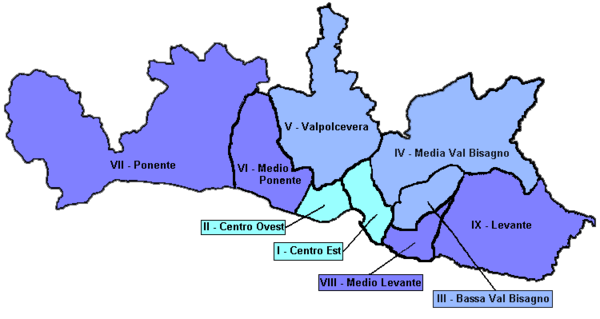Great Genoa
The term Great Genoa (Grande Genova) refers to the present area of the municipality of Genoa, in the north west of Italy. Great Genoa extends for over 30 km along the coast of Ligurian Sea from Nervi to Voltri, and up the Polcevera valley of the Polcevera river and the Bisagno river valley of the Bisagno river.

Great Genoa dates from 1926, when 19 municipalities were added to the six municipalities incorporated in 1874.[1][2]
This aggregation makes Genoa a polycentric city, as the Genoese urban area is made up of several towns each with a strong sense of belonging, a consolidated economic and social structure and an old town, so they are not perceived as "suburbs". Reflecting the strong local identity the inhabitants of many neighborhoods, former municipality, still say "I am going to Genoa" and not "I am going downtown" to state their intention to go to the city center.[2][3][4]
Historical development
The aggregation of neighboring municipalities was in 1926, but the process started many years earlier.[5]
Until 1874 the municipality of the city of Genoa was the same as the urban area surrounded by the 17th century city walls, divided into six districts, called "sestieri":
With increasing population in the 19th century, the city expanded into the hills behind the old town, but still within the city walls: during that time were built the stately neighborhood of Castelletto, and those of Oregina and Lagaccio for working class people.[6]
The annexation of 1874
After this first urban expansion it was necessary to find space for new facilities and residential neighborhoods for the middle classes.
In 1873 the mayor of Genoa Andrea Podestà proposed a plan of territorial aggrandizement in the lower Val Bisagno, which was subsequently approved by a decree of King Vittorio Emanuele II which annexed six municipalities to Genoa on 1 January 1874:[5][6][7]
- Foce
- Marassi
- San Francesco d’Albaro
- San Fruttuoso
- San Martino d’Albaro
- Staglieno
The annexation of 1926
Great Genoa was completed in 1926 when 19 municipalities were annexed to Genoa. Among them, beside some small municipalities, were towns with a strong social identity such as Sampierdarena and Sestri Ponente.[8] With this expansion the population of Genoa grew from 335,000 to 580,000 inhabitants.[5]
Annexed municipalities
In the East:
- Apparizione
- Nervi
- Quarto dei Mille
- Quinto al Mare
- Sant'Ilario Ligure
In the Bisagno valley:
- Bavari
- Molassana
- Struppa
In the Polcevera valley:
- Bolzaneto
- Borzoli
- Pontedecimo
- Rivarolo Ligure
- San Quirico in Val Polcevera
In the West:
.jpg) Nervi
Nervi Molassana
Molassana Bolzaneto
Bolzaneto- Sestri Ponente
References
- M. Spesso, G. Brancucci, "Pietre di Liguria nell’architettura di Genova – L’età del fascismo" ("The Ligurian stones in the architecture of Genoa - The age of fascism") FrancoAngeli
- P. Fusero, "Genova: periferie e centri storici : dietro le quinte della capitale europea della cultura 2004", ("Genoa: suburbs and old towns: behind the scenes of the European Capital of Culture 2004"), February 5, 2001
- F. Ferrari, "Genova, città a due volti" ("Genoa, city with two faces ")
- Historical notes in www.guidadigenova.it
- Antida Gazzola, in "Dalla città diffusa alla città diramata" ("From the sprawling city to the branched city"), by Angelo Detragiache, FrancoAngeli, 2003
- City of Genoa, Office of Statistics, "Demographic Atlas of the city", Genoa, July 2008
- "Storia dell'architettura italiana. Il primo Novecento" ("History of Italian architecture. The early 20th century", Electa, 2005, cited in
External links
| Wikimedia Commons has media related to Quarters of Genoa. |